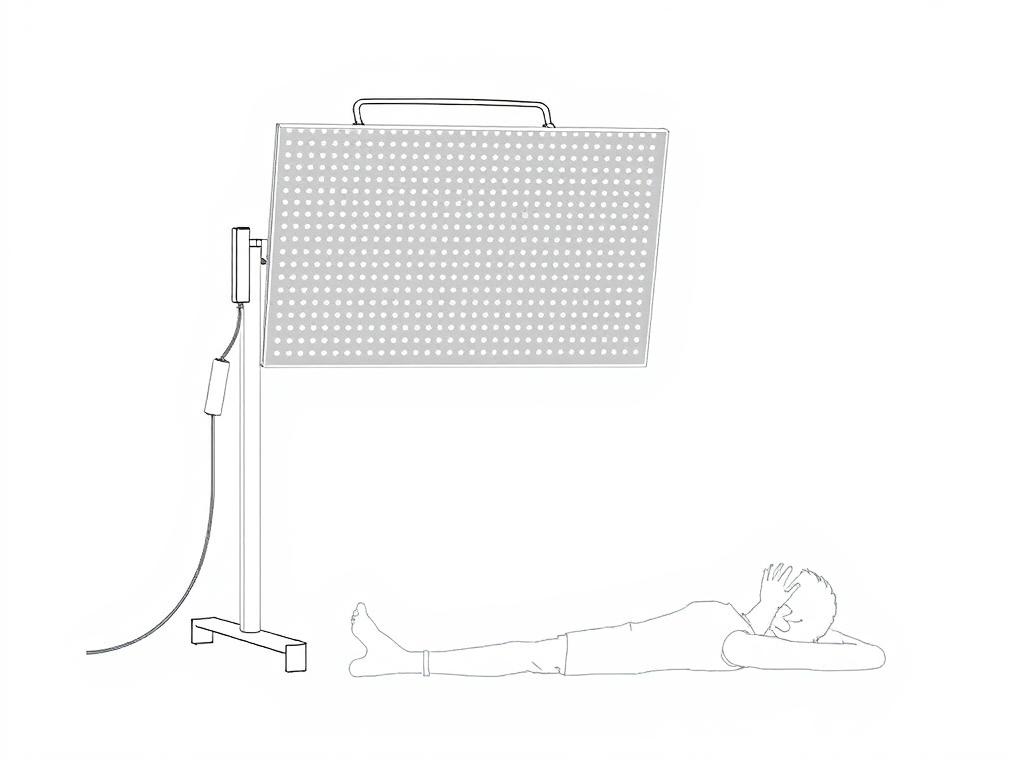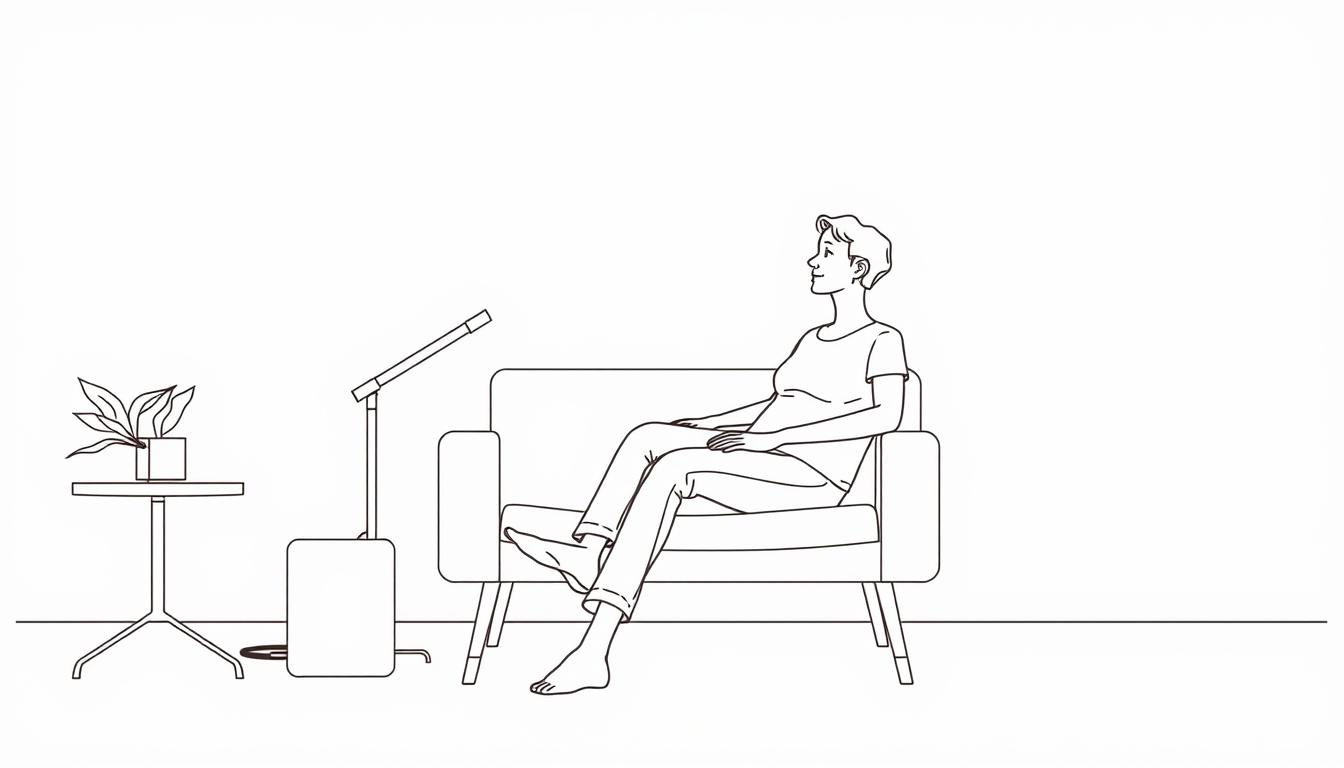Red light therapy—also known as photobiomodulation—uses specific wavelengths of red and near-infrared light to penetrate skin and tissue, stimulating cellular energy production and promoting healing. For leg-specific applications, this non-invasive therapy has shown promising results for muscle recovery, circulation improvement, and joint pain reduction.
Clinical research supports these benefits. A 2016 study by Ferraresi et al. found that red light therapy significantly reduced muscle fatigue and accelerated recovery in athletes’ leg muscles after intense training. With chronic leg pain affecting nearly 1 in 5 adults over 40 (CDC, 2023), understanding effective home treatment options becomes increasingly important.
How Red Light Therapy Works for Leg Conditions
Red light therapy works through photobiomodulation—a process where light particles (photons) are absorbed by cellular chromophores, particularly in the mitochondria. This stimulates ATP production, reduces oxidative stress, and activates signaling pathways that promote healing and reduce inflammation.
For leg-specific applications, the benefits are particularly notable:
- Increased circulation to muscles and joints
- Reduced inflammation in tendons and ligaments
- Accelerated muscle recovery after exercise
- Decreased joint pain from arthritis or overuse
- Improved collagen production for tissue repair
The effectiveness depends largely on the light’s ability to penetrate tissue. Wavelengths between 630-660nm (red light) penetrate skin layers, while 810-850nm (near-infrared) reach deeper into muscles, joints, and bone tissue—making the latter particularly effective for leg conditions.
Key Considerations for Leg Therapy
When selecting a red light therapy device for leg treatment, several factors significantly impact effectiveness:
Panel Size and Coverage
For effective leg treatment, panel size matters considerably. Smaller panels may require multiple treatment sessions to cover the entire leg area, while larger panels can treat both legs simultaneously.
Full-leg treatment typically requires panels at least 30 inches in length. The Total Spectrum Compact (30 in × 12 in with 216 LEDs) efficiently covers upper or lower legs in a single session, while the Total Spectrum Max (48 in × 12 in with 360 LEDs) can treat the entire leg length, reducing session time by approximately 30%.
Wavelength Science
Research indicates that specific wavelengths target different tissue depths and cellular responses. For leg therapy, a combination of wavelengths provides optimal results:
- 630-660nm (Red): Stimulates skin cells, promotes collagen production
- 810-830nm (Near-Infrared): Penetrates to muscle tissue, enhances recovery
- 850nm (Near-Infrared): Reaches deep tissue including joints and bone
- 1064nm (Near-Infrared): Maximum penetration for deep tissue healing
RLT Home’s seven validated wavelengths (630/633nm, 660nm, 808/810nm, 830nm, 850nm, 1064nm, plus 465nm blue) provide comprehensive coverage for various leg conditions. This multi-wavelength approach ensures treatment reaches all tissue layers from skin to deep muscle and joint structures.
Finding the right panel size and wavelength combination is crucial for effective leg therapy. The ideal device balances coverage area with the specific wavelengths needed for your condition. Compare leading panels side-by-side here to identify the optimal specifications for your needs.
Clinical Evidence for Leg Applications
The scientific foundation for red light therapy’s effectiveness continues to grow, with several high-quality studies specifically examining leg-related applications:
Muscle Recovery and Performance
Research by Hamblin et al. (2017) demonstrated that red light therapy significantly reduces recovery time after leg-intensive exercise. Their controlled trial showed that athletes receiving red light treatment experienced 42% faster recovery in muscle strength compared to the control group.
A 2022 study by Huang found cyclists using red light therapy on their legs before intense training sessions experienced both immediate performance improvements and accelerated recovery, with measurable differences in inflammatory markers and muscle damage indicators.
Inflammation and Pain Reduction
Ferraresi et al. (2016) conducted a randomized controlled trial examining red light therapy’s effect on inflammatory markers in leg muscles. Their findings showed significant reductions in key inflammatory cytokines and reported pain levels compared to placebo treatments.
For chronic conditions, a 2020 randomized study on knee osteoarthritis found that participants receiving red light therapy reported a 47% reduction in pain scores and demonstrated improved joint mobility after a 12-week treatment protocol using 810nm and 830nm wavelengths.
“The evidence increasingly supports red light therapy as a valuable intervention for leg-related conditions, particularly when appropriate wavelengths and treatment protocols are employed.”
Comparing Leading Red Light Therapy Devices for Legs
The market offers several quality options for home red light therapy. Here’s how leading brands compare for leg-specific applications:
RLT Home
Strengths: Comprehensive seven-wavelength spectrum (630-1064nm plus 465nm blue), zero measurable EMF at treatment distance, pre-programmed modes for different conditions.
The Total Spectrum Max with 360 LEDs provides full-leg coverage with high power density, reducing treatment time compared to smaller units.
PlatinumLED
Strengths: Exceptional durability with aircraft-grade aluminum housing, good heat management system, and consistent power output.
Their BioMax series offers five wavelengths that provide good coverage for most leg conditions, though they lack the 1064nm deep-penetrating wavelength found in RLT Home devices.
Joovv
Strengths: Sleek, modern design with modular components that can be arranged in different configurations. Their app integration allows for convenient session timing and tracking.
Joovv offers two primary wavelengths (660nm and 850nm), which provide good general coverage but may not address the full range of leg-specific conditions that benefit from additional wavelengths.
RLT Home Device Highlights for Leg Therapy
The Total Spectrum Ultra (64 in × 12 in, 480 LEDs) offers a motorized stand that allows for precise positioning when treating legs. This full-body panel is particularly beneficial for athletes needing simultaneous leg and back treatment, with three programmable height presets for consistent sessions.
For targeted treatment of specific leg areas like knees or ankles, the Total Spectrum Mini (12 in × 12 in, 72 LEDs) provides concentrated therapy with the same seven-wavelength spectrum as larger models, making it ideal for spot treatment of problem areas.

Practical Application for Leg Conditions
Different leg conditions benefit from specific treatment approaches:
| Condition | Recommended Wavelengths | Session Duration | Frequency | Optimal Device |
| Muscle Recovery | 660nm, 850nm | 10-15 minutes | Post-workout | Total Spectrum Compact or larger |
| Joint Pain/Arthritis | 810nm, 830nm, 850nm | 15-20 minutes | Daily | Total Spectrum Mini (targeted) or Max (full leg) |
| Circulation Issues | 630nm, 660nm, 830nm | 15-20 minutes | 3-5 times weekly | Total Spectrum Max |
| Nerve Pain | 830nm, 850nm, 1064nm | 20 minutes | Daily | Total Spectrum Ultra |
Treatment Protocol Tips
- Position the panel 6-12 inches from skin for optimal light penetration
- Expose bare skin when possible (light clothing reduces effectiveness)
- Maintain consistent treatment schedule for cumulative benefits
- Stay hydrated before and after sessions
- For muscle recovery, use within 6 hours post-exercise for best results
Safety and Support Considerations
Red light therapy is generally considered safe with minimal side effects when used properly. The National Institutes of Health has published research confirming the safety profile of red and near-infrared light therapy when appropriate parameters are followed.
Important Safety Notes: Always follow manufacturer guidelines for treatment distance and duration. While red light therapy is non-invasive, those with photosensitivity conditions, certain medications, or active cancer should consult healthcare providers before beginning treatment.
Quality devices like those from RLT Home feature zero measurable EMF at treatment distance (≥10 cm) and less than 1% flicker, minimizing potential side effects. Their pre-programmed modes for specific conditions help ensure appropriate treatment parameters.
When to Expect Results
Results timeline varies by condition:
- Acute muscle soreness: 1-3 sessions
- Chronic joint pain: 2-4 weeks of regular use
- Circulation improvement: 3-6 weeks
- Tissue healing: 4-12 weeks depending on severity
For ongoing support, RLT Home offers lifetime technical assistance and access to their human-only research library, helping users optimize their treatment protocols based on the latest clinical evidence.

Conclusion: Making an Informed Decision
Red light therapy offers evidence-based benefits for a wide range of leg conditions, from athletic recovery to chronic pain management. The key to success lies in selecting a device with appropriate specifications for your specific needs.
When evaluating options, prioritize panel size for adequate coverage, wavelength variety for comprehensive treatment, and quality construction for long-term reliability. The scientific evidence increasingly supports red light therapy as a valuable addition to leg health protocols when used consistently with appropriate parameters.
With RLT Home’s 60-day risk-free trial, you can experience the benefits of their seven-wavelength technology without commitment. Their comprehensive range from the portable Total Spectrum Mini to the full-body Total Spectrum Elite provides options for every treatment need. Compare leading panels side-by-side here to find your ideal match for effective leg therapy.
By combining quality equipment with consistent application and evidence-based protocols, red light therapy can become an effective component of your leg health and recovery strategy.
— David, independent RLT researcher

